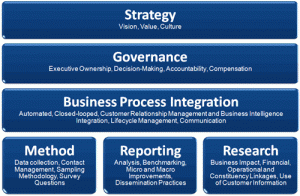In an excellent post, Bob Thompson reviews the VoC space in his blog on Voice of the Customer (Voc) Command Centers, including a discussion of 1) the six feedback dimensions, 2) how the VoC command center needs to include technology to a) capture feedback, b) analyze feedback and c) manage top priorities to resolution, and 3) the consolidation of the Enterprise Feedback Management (EFM) industry, including mention of the Verint acquisition of Vovici.
Enterprise Feedback Management (EFM) is the process of collecting, managing, analyzing and disseminating different sources (e.g., customers, employees, partners) of feedback. EFM vendors help companies facilitate their customer experience management (CEM) efforts, hoping to improve the customer experience and increase customer loyalty. The value that the Verint-Vovici solution provides their customers is stated in their press release:
“As the market’s most comprehensive VoC Analytics platform available, the Verint-Vovici solution will enable organizations to implement a single-vendor solution for collecting, analyzing and acting on customer insights.”
Advice to Verint-Vovici: VoC Programs are about People, Processes
A VoC program involves more than technology that helps companies capture, analyze and manage feedback. A VoC program contains many components, each impacting the program’s effectiveness. To improve customer loyalty, companies must consider how they structure their VoC program across these components. A VoC program has six major areas or components: Strategy, Governance, Business Process Integration, Method, Reporting, and Applied Research. Figure 1 below represents the components of customer feedback programs.
The success of VoC programs depends on proper adoption of certain business practices in each of these six areas. While each of the six areas has VoC best practice standards, the major success drivers are related to strategy/governance, business process integration, and applied research. Companies who adopt the following practices experience higher levels of customer loyalty compared to companies who do not adopt these practices:
- Customer feedback included in the company’s strategic vision, mission and goals.
- Customer feedback results used in executives’ objectives and incentive compensation.
- Customer feedback results included in the company/executive dashboards.
- Customer feedback program integrated into business processes and technology (e.g., CRM system).
- All areas of the customer feedback program (e.g., process and goals) communicated regularly to the entire company.
- Customer feedback results shared throughout the company.
- Statistical relationships established between customer feedback data and operational metrics (e.g., turnaround time, hold time).
- Applied research using customer feedback data regularly conducted.
- Statistical relationships established between customer feedback data and other constituency metrics (e.g., employee satisfaction or partner satisfaction metrics).
Reanalyzing that same data (note: the following has not yet been published), I had asked respondents about their use of third-party survey vendors and their satisfaction with these vendors. Surprisingly, I found that companies who used third-party suvey vendors did not have more loyal customers (Mean = 68th percentile in industry on customer loyalty) than companies who did not use third-party vendors (Mean = 65th percentile). Furthermore, of those companies who used third-party vendors, only 60% of the companies were satisfied (20% very satisfied) with them. The use of EFM vendors does not guarantee improvements in the customer experience and customer loyalty.
While technology will continue to play a role in improving VoC programs by capturing, aggregating and disseminating customer feedback, it appears that the success of a VoC program is more about people and processes and less about technology. The Verint-Vovici solution (for that matter, all EFM solutions), to be successful, need to cognizant of all components of their customer’s VoC program and must consider how their technology will improve the people and processes (building a customer-centric culture).
Assessing your VoC Program
The way your VoC program is structured impacts its success. If you are a VoC professional who manages customer feedback programs for your company, you can take the Customer Feedback Program Diagnostic (CFPD) to determine if your VoC program adopts best practices. This brief assessment process can help your company:
- identify your customer feedback program’s strengths and weaknesses
- understand how to improve your customer feedback program
- facilitate your customer experience improvement efforts
- increase customer loyalty
- accelerate business growth
Upon completion of this 10-minutes assessment, you will receive immediate feedback on your company’s VoC program. Additionally, all respondents will receive a free summary report of the research findings. Take the CFPD now.




